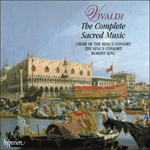Numbered RV623 in the standard modern Vivaldi catalogue by Peter Ryom, Canta in prato, ride in monte is another of the ‘Roman’ motets. The singer for whom Vivaldi wrote Canta in prato (not to be confused with an introductory motet, RV636, set to a bastardized version of the same text) may well also have been one of the principal singers in his operas, for the best voices migrated freely between choir-loft and stage. This joyful motet is suited to any festival of a saint (who is invoked simply as ‘Pater beate’ in the recitative). The reference in the first aria to the nightingale, described in classical fashion as ‘Philomela’, calls forth some bird-like warbles, familiar from such Vivaldi concertos as ‘Il gardellino’. The second aria stays close to this style with its evocation of the tootling of rustic flutes. This is Vivaldi at his most beguiling and uncomplicated.
from notes by Michael Talbot © 1996
Canta in prato, ride in monte motet (RV623) appartient à un groupe de motets pour soliste soprano, dont trois subsistent, que Vivaldi composa lors d’un de ses séjours à Rome, dans les années 1720. Deux de ses passages dans cette ville sont attestés, l’un à la saison carnavalesque de 1722/3, l’autre à la même saison, l’année suivante. Il aurait encore passé une autre saison carnavalesque à Rome, mais nous ignorons quand. Le chanteur auquel il destina Canta in prato (à ne pas confondre avec le motet introductif RV636, sur une version corrompue du même texte) a fort bien pu être un des interprètes principaux de ses opéras, car les meilleures voix circulaient librement de la tribune du chœur à la scène. Ce motet joyeux convient à n’importe quelle fête de saint (le récitatif l’invoquant simplement sous l’appellation «Pater beate»). Dans la première aria, la référence au rossignol—désigné, selon le mode classique, par le terme «Philomela»—suscite les gazouillis aviens entendus dans les concertos de Vivaldi, comme «Il gardellino». La seconde aria demeure proche de ce style par son évocation du sifflotement de flûtes champêtres. Vivaldi est alors au summum de son charme et de sa simplicité.
extrait des notes rédigées par Michael Talbot © 1996
Français: Hyperion Records Ltd
Canta in prato, ride in monte, RV623, gehört zu einer Reihe von drei erhalten gebliebenen Solomotetten für Sopran, die Vivaldi in den 1720ern während einem seiner Besuche in Rom komponierte. Zwei Aufenthalte in Rom, einer zur Karnevalszeit 1722/23 und ein anderer aus gleichem Anlaß ein Jahr darauf, sind dokumentiert, und wahrscheinlich besuchte er Rom noch ein weiteres Mal zur Karnelvalszeit, was bis heute noch nicht bewiesen ist. Der Sänger, für den er Canta in prato schrieb (nicht zu verwechseln mit einer Einführungsmotette, RV636, die zu einer ungeschickten Bearbeitung desselben Textes vertont wurde), mag sehr wohl einer der Hauptsänger seiner Opern gewesen sein, denn die besten Stimmen wanderten zwischen Empore und Bühne frei umher. Diese fröhliche Motette paßt zu jeder Heiligenfeier (der Heilige wird im Rezitativ ganz einfach mit „Pater beate“ angerufen). Das Erwähnen der Nachtigall durch das klassische „Philomela“ in der ersten Arie ruft einige vogelähnliche Triller hervor, die aus Konzerten Vivaldis wie „Il gardellino“ bekannt sind. Die zweite Arie hält sich mit ihrem Heraufbeschwören einzelner Klänge der rustikalen Flöte eng an diesen Stil. Dies ist der betörendste und unkomplizierteste Vivaldi.
aus dem Begleittext von Michael Talbot © 1996
Deutsch: Ute Mansfeldt


 Vivaldi: The Complete Sacred Music
Vivaldi: The Complete Sacred Music
